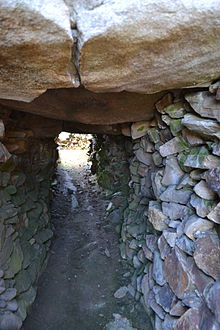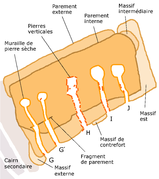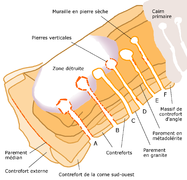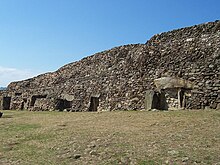Cairn by Barnenez
The Neolithic megalithic complex of Barnenez is located in the Breton municipality of Plouezoc'h , on the Kernéléhen peninsula in the northern Finistère department in Brittany in France . Barnenez originated around 4500 BC. BC, making it one of the oldest megalithic systems in the world. At the time of its construction, the hill overlooked a fertile plain, today's Morlaix Bay . It has enormous dimensions. The structure, weighing 13,000 to 14,000 tons, is 72 m long, up to 25 m wide and 8 m high.
Statistical
Its builders needed 1,500 kg of stone for one cubic meter of the Barnenez mound. From breaking and splitting the stones , to transporting and stacking them, this means four days of work for a worker, assuming a 10-hour day. Taking into account the cavities of the original hill, the volume is 2,000 cubic meters. This means that around 3,000 tons of dolerite and 1,000 tons of granite were processed here. According to Pierre-Roland Giot (1919–2002), the total working time on the hill was 15,000 to 20,000 working days. With 200 workers, the construction of the hill would have taken about 3 months. The total volume of the various sections of the hill is almost three times the volume of the first phase hill.
- Phases of Barnez
excavation
As early as 1850, the Barnenez complex was classified as a tumulus at a congress of the learned society of Morlaix . When stones were removed for road construction at the beginning of the 1950s , the dolmens , some of which had cantilever vaults , were found , which justify the megalithic classification of the otherwise small-sized rock in two phases. The facility was used as a quarry until 1954 when the community intervened to protect the grave. Between 1954 and 1968 it was restored and the vegetation removed. Excavations were also carried out around the entire facility, the results of which can be viewed today in the exhibition in the reception building.
description
In French terminology, the eleven chambers in Barnenez's tomb are dolmen à couloir; pierre sèche . They consist of stone, slate and granite slabs . In the first construction phase, a trapezoidal hill (32 m × 13 m) with a double enclosure and five dolmens was built in the east (Cairn 1, approx. 4,500 BC). This is followed by a hill widening with six dolmens (Cairn 2, approx. 4,200–3,900 BC). All eleven dolmens have a long corridor and were arranged in parallel, the chambers differ slightly in shape and construction. The width of the hill, which is over 72 m long and 6 m high, is originally estimated to be 8 to 9 m.
Nine narrow corridors lead into a vaulted chamber that rests on supporting stones and in one case extends from the floor. Dry stone walls or stone slabs were used for the walls. All corridors were covered horizontally with overhangs. A dolmen has an antechamber with a dome made of corbels. There are engravings in three dolmens. They show bows, axes, and wave symbols. One of the engraved stone slabs comes from another dolmen and was used secondarily in the Barnenez tumulus. Pottery shards found in the forecourt prove that the building was used until the Bronze Age .
Only in hill 2, in chambers A, C and D, were finds from the Neolithic era unearthed during the excavation , ceramics, cut axes made of dolerite , blades made of flint and arrowheads. A copper dagger and a winged arrowhead with barbs come from the Chalcolithic era . Five blocks were decorated with engravings. Barnenez's images are similar to those of other megalithic sites in Brittany. Frequently a goddess were as abstract representations interpreted, U-shaped or horn-shaped characters, arcs, and axes , axes , Axtpflüge ( French Hache-charrue ) and as snakes attached interpreted representations.
22 similar hills can be found in northern France and on the island of Jersey . In Brittany, there are the Larcuste , Le Bono, Petit Mont, Ty-Floc'h, Gavrinis , Île Carn near Ploudalmézeau and Île Guennoc off the coast of Landéda . In Guennoc's paved Tholos 3B there is a small menhir to the side of the entrance. The conservation status on the small islands is usually better. In Normandy, there are mainly La Hogue in Fontenay-le-Marmion with eight chambers and the round twin chambers of Condé-sur-Ifs.
literature
- Jacques Briard : Mégalithes de Bretagne . Ouest-France, Rennes 1987, ISBN 2-7373-0119-X .
- Pierre-Roland Giot: Barnénéz. Carn. Guennoc . Travaux du Laboratoire d'Anthropologie, Préhistoire, Protohistoire et Quaternaire Armoricains, Rennes 1987.
- Pierre-Roland Giot: Prehistory of Brittany. Menhirs and dolmens . Édition d'Art Jos Le Doaré, Châteaulin 1996, ISBN 2-85543-103-4 .
See also
Web links
- http://barnenez.monuments-nationaux.fr/fichier/m_docvisite/19/docvisite_fichier_14E.cairn.DE.pdf
- Stone circles dolmen menhirs
- Page from monum.fr in French with opening times of the Cairn
- Page in French with pictures of the Cairn
- Information page about Barnenez Cairn at "The Megalithic Portal"
Coordinates: 48 ° 40 ′ 3.4 " N , 3 ° 51 ′ 30.6" W.








